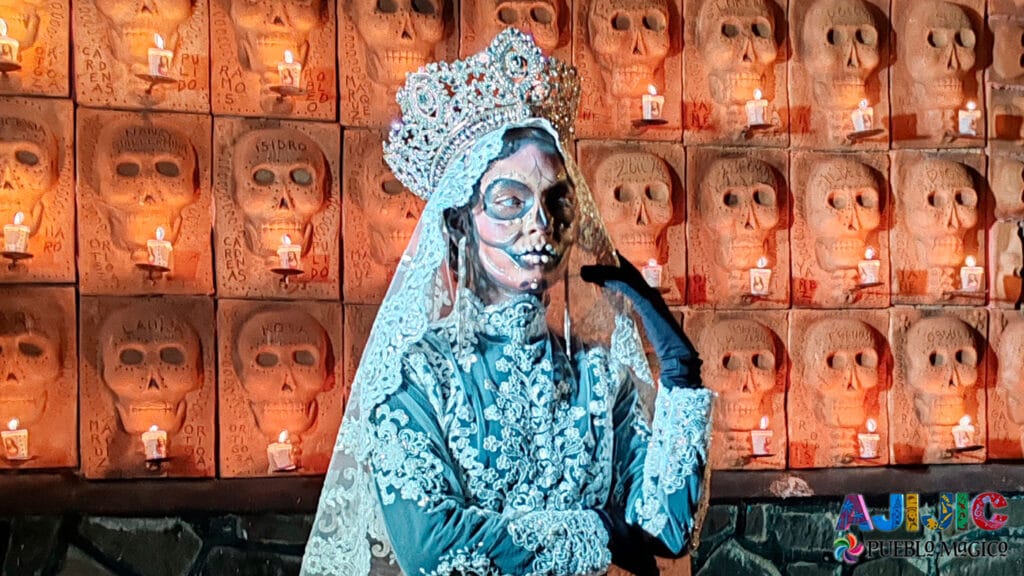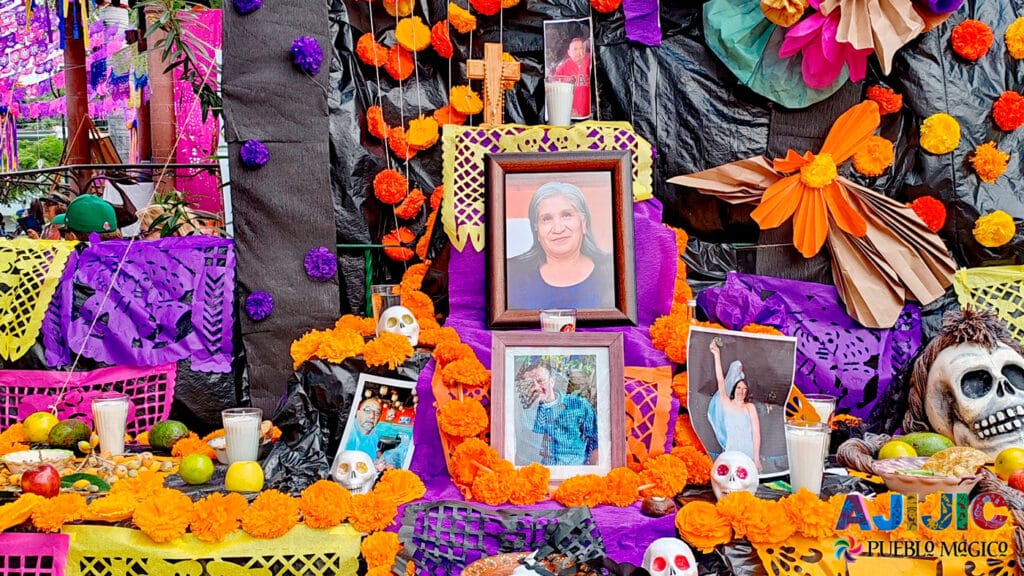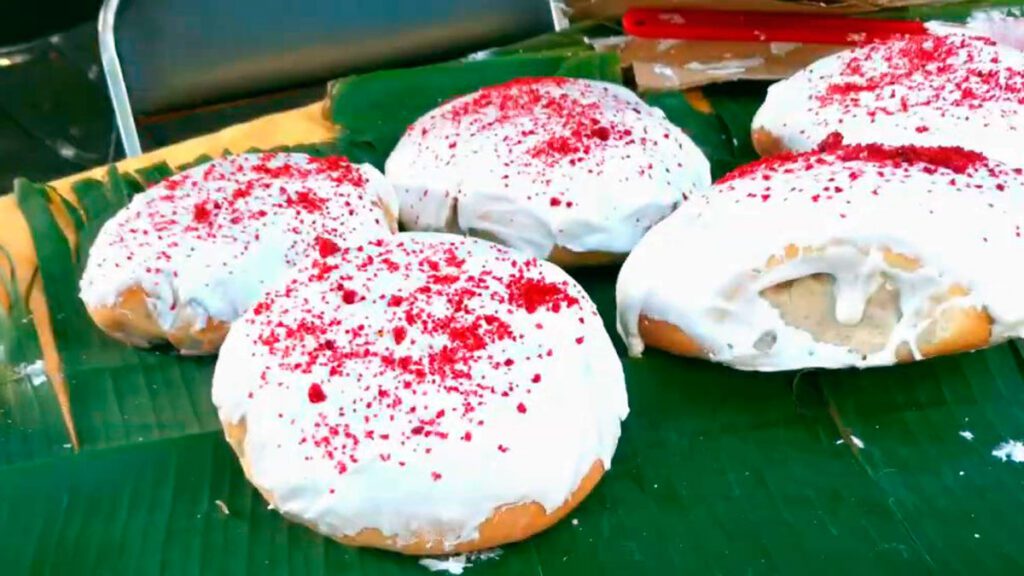¿Qué es el Día de Muertos y por qué es especial en Ajijic?
El Día de Muertos es una de las celebraciones más importantes y emblemáticas de México. Se conmemora el 1 y 2 de noviembre y está dedicada a recordar, honrar y celebrar la vida de los seres queridos que han fallecido. A diferencia de otras culturas donde la muerte puede ser un tema solemne o temido, en México se vive con color, música y alegría, reconociéndola como parte natural del ciclo de la vida.
Esta tradición tiene raíces prehispánicas. Pueblos originarios como los mexicas, mayas, purépechas y totonacas ya realizaban rituales para rendir tributo a sus muertos. Cuando llegaron los españoles en el siglo XVI, las prácticas indígenas se fusionaron con las festividades católicas del Día de Todos los Santos y el Día de los Fieles Difuntos, dando lugar a lo que hoy conocemos como Día de Muertos.

Los elementos más característicos incluyen:
- Altares (ofrendas) decorados con flores de cempasúchil, fotografías, velas, comida, papel picado y objetos personales del difunto.
- Calaveras de azúcar y pan de muerto, que simbolizan la vida y la muerte de forma alegre.
- Catrinas, figuras de esqueletos elegantemente vestidas que representan con humor la igualdad ante la muerte.
- Visitas a los panteones, donde las familias limpian, decoran y velan las tumbas de sus seres queridos, compartiendo música y alimentos.
¿Por qué Ajijic celebra el Día de Muertos de forma única?
Ajijic, declarado Pueblo Mágico por su riqueza cultural, se distingue por su fusión de tradiciones ancestrales con una comunidad artística vibrante y una notable población extranjera. Esto crea una celebración multicultural donde conviven lo tradicional y lo contemporáneo.

Durante el Día de Muertos, Ajijic se transforma: sus calles empedradas se llenan de arte efímero, música tradicional, tapetes de aserrín, desfiles y ofrendas colectivas que involucran a toda la comunidad. Es una experiencia profundamente conmovedora y visualmente espectacular, que invita a locales y visitantes a participar activamente, sin importar sus orígenes.
Aquí, más que un evento turístico, el Día de Muertos se vive como una oportunidad para conectar con la memoria, con los antepasados y con la identidad de un pueblo que honra la vida a través de la muerte.
Festival Axixic Vive: La Magia del Día de Muertos en Ajijic
Cada año, el pueblo de Ajijic celebra el Día de Muertos con el Festival Axixic Vive, una fiesta cultural y comunitaria que transforma las calles del centro, la plaza principal y el malecón en un escenario lleno de color, arte y tradición. Este festival busca preservar y compartir la riqueza del Día de Muertos, combinando expresiones artísticas con costumbres locales, todo en un ambiente familiar y festivo.

El corazón del festival son las artes escénicas, con una cartelera que incluye presentaciones de danza, teatro, música en vivo, cuenta cuentos y calaveritas literarias, todas interpretadas por artistas locales. También destacan instalaciones como “La Serenata”, una obra monumental que representa catrinas de gran formato, y eventos visualmente impactantes como el vals de catrines y catrinas, los desfiles temáticos y la tradicional ofrenda floral al lago.
Además, el evento mantiene viva la esencia popular con la participación de globos de cantoya en el espectáculo “Luz al Cielo”, puestos gastronómicos con recetas mexicanas tradicionales y actividades para toda la familia. El festival culmina con música en vivo, mariachis y el esperado Baile de los Muertos, una noche llena de ritmo, comunidad y homenaje a quienes ya no están.
Organizado por el Patronato Día de Muertos Ajijic junto a artistas, escuelas y vecinos, este festival es un reflejo de la magia, la unión y la identidad que hacen de Ajijic un verdadero Pueblo Mágico. La programación y actualizaciones se publican cada año en medios locales y en la página de Facebook del Patronato.
Principales actividades del festival:
- Altar Comunitario en el Malecón: Un altar monumental donde se colocan ofrendas para honrar a los fallecidos.
- Tapetes de Aserrín: Coloridas alfombras hechas con aserrín teñido, que adornan las calles principales.
- Desfile de Angelitos: Niños vestidos de blanco desfilan en honor a los niños difuntos.
- Desfile de Catrinas y Catrines: Personas disfrazadas con trajes tradicionales recorren el pueblo en una procesión llena de música y alegría.
- Concurso de Xoloitzcuintles: Perros de esta raza autóctona desfilan con atuendos alusivos al Día de Muertos.
- Muro de los Muertos: Una instalación artística donde se colocan veladoras y mensajes para recordar a los seres queridos.

Aquí tienes una agenda oficial organizada del Festival Axixic Vive 2025: “El Lago Es Nuestra Tradición”, redactada de forma clara, estructurada y atractiva para publicación o difusión:
Axixic Vive 2025: “El Lago Es Nuestra Tradición”
El Pueblo Mágico de Ajijic se prepara para celebrar la cuarta edición del Festival de Día de Muertos “Axixic Vive”, un evento que honra la vida, las tradiciones y el espíritu del Lago de Chapala. Bajo el lema “El Lago Es Nuestra Tradición”, este año el festival rinde tributo al equilibrio ecológico, social y cultural del lago, incorporando además a la mariposa monarca como símbolo del regreso de las almas.
Fechas Principales
- 30 y 31 de octubre: Actividades previas e inauguración artística.
- 1 y 2 de noviembre: Festival principal en la Plaza Principal y Malecón de Ajijic.
SÁBADO 1 DE NOVIEMBRE, DÍA DE LOS ANGELITOS
11:00 a 17:00 horas – Talleres infantiles “Letras para Volar” UdeG y Pabellón Prisa
15:00 – Apertura del Pabellón Gastronómico por Casa Axixic
16:30 – Presentación de la cantante infantil Cosette, música mexicana
17:00 – Desfile de Angelitos. Recorrido: 6 esquinas, Ocampo, Constitución, Marcos Castellanos, Pasillo del arte y plaza principal
17:45 – Inauguración de exhibición fotográfica “Memorias de Ajijic”
18:00 – Ballet folclórico infantil Xicantzin
18:45 – Proyección de Cine infantil
19:00 – Obra de teatro “Mientras duermes, la muerte baila”, Malecón de Ajijic
20:00 – “Xantollo”, Recorrido: malecón de Ajijic, Morelos–Colón y plaza principal
DOMINGO 2 DE NOVIEMBRE, DÍA DE MUERTOS
Plaza Principal:
11:00 a 20:00 horas – Talleres infantiles “Letras para Volar” UdeG y Pabellón Prisa
14:00 – Apertura de exhibición de ofrendas, altares y tapetes
14:00 – Cantante infantil Cosette, música mexicana
15:00 – Apertura del Pabellón Gastronómico por Casa Axixic
15:00 – Ballet folclórico infantil y juvenil “Axixic”, de la Mtra. Andrea García Mariscal
16:00 – Ensamble coral de la Preparatoria 2 de la UdeG
17:00 – Alabanzas / Performance “Descenso de las ánimas”
17:30 – Pieza teatral “Boda Catrina”, atrio de la Capilla del Rosario y plaza principal
18:00 – Presentación artística por confirmar
19:00 – Grupo del Tecnológico Superior de Chapala
20:00 – Groobeaners, música R&B, Funk, Pop
20:00 – Encendido del “Muro de los Muertos”, calle Marcos Castellanos y Parroquia
20:00 – Performance “El último adiós al angelito”, recorrido por la plaza y calle Colón
Malecón:
14:00 – Inauguración del Altar comunitario por Lake Chapala Society
14:00 – Apertura del Pabellón Gastronómico por Manos Solidarias
15:30 – Concurso de xoloitzcuintles “Camino al Mictlán”
16:00 – Ballet Folclórico de Pátzcuaro, Michoacán
17:00 – Presentación artística por confirmar
17:30 – Desfile de Catrinas y Catrines. Recorrido: salida en Casa Axixic (Ocampo 202), Ocampo, Morelos, hasta el malecón
17:30 – Desfile de canoas, se podrá ver desde el malecón poniente y Parque de la Amistad
18:00 – Coro Centro Regional de Estudios Musicales CREM, Dir. Emmanuel Medeles
19:00 – Mariachi Nuevo Chapala, Dir. Moisés Real
19:00 – Ofrenda al Lago
19:45 – Pasarela y Vals de Catrinas y Catrines
21:00 – Baile de los Muertos, grupo versátil
21:30 – “Luz al Cielo” (lanzamiento de globos de Cantoya), skatepark
Participación Institucional
El festival cuenta con la colaboración de instituciones educativas y organizaciones locales:
- Centro Universitario de Chapala (CUChapala)
- Instituto Tecnológico Superior de Jalisco (ITS Chapala)
- Manos Solidarias
- Colegio Octavio Paz
- Universidad URIT Chapala
- CETAC Ajijic
Concursos y Actividades Especiales
Concurso de Pintura “Devoción, Tradición y Simbolismo”
🗓️ Inauguración: 30 de octubre, 5:00 p.m. — Centro Cultural Ajijic (CCA).
🏆 Premios:
🥇 $4,000 🥈 $3,000 🥉 $2,000
Concurso de Disfraces Xoloitzcuintle
📅 Fechas: 1 y 2 de noviembre.
🎭 Temática: Día de Muertos.
🏆 Premios: $1,000 — $800 — $500.
📞 Inscripciones: 33 28 38 94 67
📧 Correo: pdiademuertosajijic@gmail.com
Escenarios y Espectáculos
Los escenarios estarán activos de 3:00 p.m. a 11:00 p.m. con música y danza en vivo.
- Mariachi: 8:00 p.m. — Malecón de Ajijic 🎻, 2 de noviembre
- Baile de los Muertos: 9:45 p.m. — Plaza Principal 🎊
- Performances Callejeros:
- “Lamento por los muertos” (6:00–9:00 p.m.)
- “Adiós al angelito” (7:00–7:30 p.m.)
- “El último viaje del campesino” (8:30–9:00 p.m.)
Andador Gastronómico y Muestra Cultural
Desde las 3:00 p.m. en el Parque de la Amistad, se instalará un andador gastronómico con antojitos y platillos típicos para recaudar fondos a favor de la asociación Manos Solidarias.
Cierres Viales
📍 Calles afectadas: Colón, Parroquia, Morelos y parte de Marcos Castellanos.
🕗 Horario: 8:00 a.m. – 11:00 p.m. (2 de noviembre).
Un Festival para Honrar, Recordar y Celebrar
“Axixic Vive 2025” no es solo un festival, es un homenaje a las raíces, a la comunidad y a la vida misma. Entre altares, catrinas, música, luces y arte, Ajijic reafirma su compromiso con la cultura mexicana y la preservación del Lago de Chapala.
Arte y Cultura en Cada Rincón
Ajijic es conocido por su vibrante escena artística, y el Día de Muertos no es la excepción. Durante el festival, se pueden apreciar:

- Exposiciones fotográficas: Muestran la historia y tradiciones del pueblo.
- Presentaciones de danza y música: Grupos locales interpretan piezas tradicionales.
- Teatro callejero: Obras que narran leyendas y cuentos relacionados con la festividad.
Gastronomía Típica del Día de Muertos
La comida es una parte esencial del Día de Muertos porque representa el amor y la memoria hacia quienes ya no están. En los altares se colocan los platillos favoritos de los difuntos, como muestra de cariño, y durante las celebraciones públicas se pueden degustar alimentos tradicionales que también ayudan a mantener viva la cultura.

Pan de Muerto
Este pan es quizá el símbolo más representativo de esta festividad. Se trata de un pan dulce, redondo, con una textura suave y ligeramente densa, cubierto con azúcar. La parte superior está decorada con “huesitos” de masa que simbolizan los restos de los difuntos y una bolita central que representa el cráneo. En algunas regiones se aromatiza con azahar o ralladura de naranja, evocando la fragancia del altar. Se acompaña comúnmente con chocolate caliente o café de olla.
Tamales
Los tamales son un platillo de origen prehispánico preparado a base de masa de maíz rellena, envuelta en hojas de maíz (totomoxtle) o de plátano, y cocida al vapor. Durante el Día de Muertos, es común ofrecer tamales de sabores variados: de chile rojo o verde con carne, de mole, de dulce con pasas y canela, o incluso rellenos de frutas. En Ajijic, como en muchas partes de México, los tamales forman parte de la ofrenda y también se comparten entre familias y vecinos.
Atole
El atole es una bebida espesa y caliente hecha tradicionalmente con masa de maíz disuelta en agua o leche, endulzada y aromatizada con canela y vainilla. Existen muchas variantes: atole blanco, de chocolate, de nuez o guayaba. Es una bebida reconfortante que acompaña al pan de muerto o los tamales, especialmente durante las noches frías de noviembre. Su origen también es prehispánico, y en el contexto del Día de Muertos representa el alimento espiritual que ayuda a las almas en su travesía.
Calaveritas de Azúcar
Estas pequeñas calaveras decorativas están hechas de azúcar prensada, aunque también existen de chocolate, amaranto o tamarindo. Se decoran con glaseado de colores, papel metálico y, a veces, llevan nombres en la frente. Se colocan en los altares como símbolo de la vida efímera, con un toque de humor. Las calaveritas no solo se comen, también se regalan entre amigos y familiares como una forma de recordar, con cariño y ligereza, que todos compartimos el mismo destino.
¿Cómo Llegar a Ajijic?
Ajijic se encuentra en el estado de Jalisco, a aproximadamente una hora en coche desde Guadalajara. Se puede llegar por carretera tomando la autopista hacia Chapala y luego siguiendo las señales hacia Ajijic.
Elementos Tradicionales del Día de Muertos
Los elementos que conforman una ofrenda de Día de Muertos no están ahí por casualidad. Cada uno tiene un profundo significado simbólico y espiritual. La combinación de estos objetos en el altar refleja una cosmovisión que mezcla lo prehispánico con lo católico, lo terrenal con lo espiritual.
A continuación, te explicamos cada uno de estos elementos esenciales:

Fotografías
Las imágenes de los seres queridos fallecidos se colocan en el nivel superior del altar como una forma de llamarlos y rendirles tributo. La fotografía representa la presencia espiritual de la persona homenajeada. Según la creencia, si no se incluye su imagen, el alma no puede visitar el altar. Es común colocar más de una foto, especialmente si se honra a varios miembros de la familia.
Comida y Bebida
En el altar se colocan los platillos favoritos del difunto, como forma de honrar sus gustos en vida. Se cree que las almas “absorben la esencia” de estos alimentos durante su visita. Algunos de los más comunes son mole, tamales, frutas, pan de muerto, atole y tequila o mezcal, dependiendo de la costumbre local o del difunto. En algunos casos, se incluyen alimentos de temporada como calabaza en tacha (calabaza cocida con piloncillo y canela).
Veladoras
Las velas y veladoras representan la luz que guía a las almas en su regreso al mundo de los vivos. Se colocan en número impar, y su disposición varía según el nivel del altar. Algunas personas forman una cruz con cuatro velas, simbolizando los cuatro puntos cardinales, para que el alma no se pierda. Las velas pueden ser blancas, moradas o del color que represente al difunto.
Flores de Cempasúchil
La flor de cempasúchil, conocida como “la flor de los muertos”, es originaria de México. Su color anaranjado vibrante y su fuerte aroma se consideran guías espirituales que ayudan a los difuntos a encontrar el camino hacia su altar. Se utilizan tanto en arreglos florales como en caminos desde la entrada del hogar hasta el altar. El uso de pétalos es una de las costumbres más arraigadas en lugares como Ajijic.
Papel Picado
El papel picado es una artesanía de papel de colores recortado con figuras alusivas a la muerte. Representa el viento, uno de los cuatro elementos. Además, al ser tan frágil, simboliza la delicadeza de la vida. Se coloca como adorno en diferentes niveles del altar y aporta alegría visual. Es muy común ver colores como el morado (duelo), el naranja (vida), y el blanco (pureza).
Pan de Muerto
El pan de muerto es un pan tradicional que simboliza el ciclo de la vida y la muerte. Su forma redonda representa el círculo de la vida, y los “huesos” en la parte superior aluden a los restos de los difuntos. La bolita central representa el cráneo. Se coloca como parte de la ofrenda y también se consume en familia. Su presencia en el altar es casi obligatoria en todo México.
Hospedaje y Recomendaciones
Durante el festival, es recomendable reservar alojamiento con anticipación debido a la alta demanda. Ajijic ofrece diversas opciones, desde hoteles boutique hasta casas de huéspedes. Quieres conocer mas acerca de que hotel reservar, visita este articulo con mas informacion:
Preguntas Frecuentes (FAQ)
¿Cuándo se celebra el Día de Muertos en Ajijic?
El 1 y 2 de noviembre, coincidiendo con las fechas tradicionales mexicanas.
¿Es necesario pagar para asistir al Festival Axixic Vive?
La mayoría de las actividades son gratuitas y abiertas al público.
¿Puedo participar en los desfiles?
Sí, los visitantes pueden unirse a los desfiles. Se recomienda vestir con atuendos tradicionales o maquillaje de catrina.
El Día de Muertos en Ajijic es una experiencia única que combina tradición, arte y comunidad. Es una oportunidad para honrar a los seres queridos en un ambiente lleno de color y vida. ¡No te lo pierdas!













